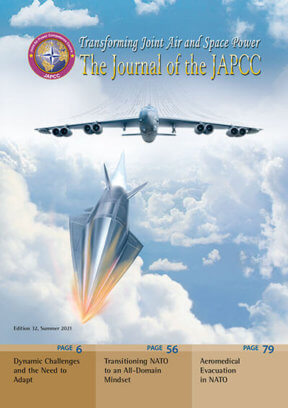Introduction
For most people, hypersonic weapons and aircraft represent yet another 21st century technological breakthrough in which science fiction becomes science fact.1
However, hypersonic studies have an extended history stretching back over half a century. In October 1967, William J. Knight, an aeronautical engineer, piloted the X-15 to the official world record for the highest speed ever recorded by a manned rocket-powered aircraft. On that occasion the North American X-15, a hypersonic jet operated by the United States (US) Air Force, flew Mach 6.7 at 102,100 feet. Following the success of this hypersonic vehicle, the US Air Force focused on developing technologies to enable the use of hypersonic speeds across a range of applications. A series of hydrocarbon-fueled direct-connect scramjet ground tests were successfully completed in the National Aeronautics and Space Administration’s (NASA) Langley Arc-Heated Scramjet Test Facility in 2011.2
This new variety of engine was tested on the Boeing X-51 ‘Waverider’ which flew a few times between 2010 and 2013 and demonstrated the potential viability of a scramjet-powered vehicle for weapon applications.
This article aims to convey to the reader a brief overview of the technology itself and provide a few thoughts regarding various scenarios and threat implications these weapons could create in future conflicts.
Today, press reports indicate that the US, Russia, and China are leading the race to develop hypersonic glide and cruise missiles to penetrate defended airspace. China and Russia are reportedly conducting tests of these high-speed weapons as an asymmetric response to American military superiority. Russia, who is working on several hypersonic projects, such as ‘Avangard’ and ‘Kinzhal’, has successfully tested the hypersonic anti-ship cruise missile ‘Zircon’, which has already been assigned a NATO reporting designation of SS-N-33. This indicates that the missile is expected to come into service soon and that the Alliance is treating the reports of its development fairly seriously. The ‘Kinzhal’ and the ‘Avangard’ are reported operational3 while the ‘Zircon’ is still in the development phase. China is fully involved in this race as well. In his testimony to the Senate Armed Services Committee on 13 February 2020, US Air Force General Terrence O’Shaughnessy, Commander of US Northern Command (USNORTHCOM) and North American Aerospace Defense Command (NORAD), noted that China is testing a Hypersonic Glide Vehicle (HGV) similar to the Russian ‘Avangard’ system. The state-owned China Aerospace Science and Technology Corporation (CASC) claimed in August 2018 that it had successfully developed and tested China’s first experimental hypersonic waverider4, called ‘Xing Kong 2’ (or Starry Sky-2). Some reports indicate that the Starry Sky-2 could be operational by 20255. Another Chinese boost-glide weapon project is the DF-ZF, which recently has been shown on a Dong Feng DF-17 missile during a parade in China, after multiple test shots between 2014 and 2018.6
The US Air Force is working on multiple programs. One of these is the hypersonic Air-Launched Rapid Response Weapon (ARRW) produced by Lockheed Martin’s Space Systems division. ‘The rocket-boosted ARRW is one of the air-launched hypersonic missiles publicly known to be undergoing testing by the Pentagon, which considers the project a necessary step to maintain an edge over near-peer competitors China and Russia.’7 ‘The work will be run out of Orlando, Florida, and is expected to be complete by the end of 2022 – when the missile is expected to reach operational capability.’8
Other countries are also beginning to show an interest in hypersonic weapons technologies. France, India and Japan are close behind the first three, while Australia and other European countries are developing the component technologies for ostensibly civilian purposes such as Satellite/Spacecraft launch and repair, deliveries to the space station and space tourism.
What is Hypersonic?
Airspeed is a measurement of a plane’s speed relative to the air around it and is frequently expressed in terms relating to the speed of sound. The speed of sound is set at ‘Mach one’ which is approximately 340 m/s (761 mph) or 1225 km per hour at sea level. Commercial airliners fly right under Mach one at subsonic speeds, while modern fighters can fly supersonic at Mach two or three. By definition, hypersonic weapons can travel at least five times this speed.
Anything travelling Mach five and above is considered hypersonic. The technology, which is just now emerging, enables sustained hypersonic flight for a significant distance and time. This is typically achieved by employing scramjet (Supersonic Combusting Ramjet) engines. The scramjet is a new modified version of the ramjet. Scramjet takes the oxygen needed by the engine to combust from the atmosphere passing through the vehicle instead of from a tank onboard.9 These engines have fewer moving parts than the turbofan engines which can be found on conventional jet planes. They require an initial speed of approximately Mach 4 to ignite the fuel and generate thrust. This is the reason why a boost engine is mandatory. However, these engines are not mature yet. According to a US Air Force Scientific Advisory Board report, they were expected to reach an adequate level of maturity by the end of 2020 in order to shift the focus of the economical efforts from technology development towards product development.10 ‘Currently, no hypersonic efforts are in production. The US Air Force’s Air-launched Rapid Response Weapon is expected to be the first to achieve a residual operational capability where production decisions can be made after fielding at the end of fiscal year 2022.’11
Emerging Weapons
The main reason for the development of hypersonic weapons is to hold opponents’ mobile targets at risk and to improve the ability to penetrate advanced integrated air defence systems. It is common understanding that these new weapons could have significant impact on strategic stability.12
There are two types of weapons emerging: Hypersonic Cruise Missiles (HCM) and Hypersonic Glide Vehicles (HGV).
HCM’s are powered to their targets using the advanced propulsion system described earlier, the scramjet. They are very fast and manoeuvrable, hence defenders may have just a few minutes from the time they are launched until they strike their targets. The HGV is placed on top of rockets launched to extremely high altitudes where it is released at the appropriate altitude, velocity, and flight path angle, and enabled to glide and manoeuvre to its target. China’s ‘Xing Kong 2’, Russia’s ‘Avangard’, and the American Tactical Boost Glide (TBG) and ARRW projects, are all example of HGV, which maintain stability to fly along and to manoeuvre, keeping their targets hidden until the last few seconds of flight.13
Challenges to Hypersonic Capability
There are four primary hurdles to the development of hypersonic weapons: manoeuvrability, material, speed, and communication.
First, the aerodynamics and flight controls for flight at hypersonic speeds are a significant challenge; hypersonic airflow is different from supersonic airflow in that it is nonlinear and experiences different physical effects.
The second challenge is material science. ‘The faster the vehicle flies both the pressures and temperatures rise exponentially.’14 All of this ‘requires materials that can withstand high temperatures over long periods of time’.15
The third challenge involves the propulsion systems of hypersonic cruise missiles. Once they reach Mach 5, it is not possible to use the traditional jet engines. At these speeds, a completely different design is needed to enclose the airflow path and sustain combustion of the supersonic airflow inside the engine.
In addition to these hurdles, in this current operating environment, data exchange also appears to be a unique technical challenge. ‘Basic operations, like communications, become significant during hypersonic flight. Personnel need continuous connectivity to operators and decision makers through global communications and sensor systems that can operate within these high-speed environments’16 as stated by Scott Greene, executive vice president of Missiles and Fire Control (MFC) for Lockheed Martin Corporation.
Is NATO Prepared to Counter Hypersonic Weapons?
Hypersonic systems provide advantages in terms of speed to target, manoeuverability and survivability to reach well-defended targets.17
High speed means less warning time. Until now, NATO has been reasonably confident that its collective intelligence capabilities would alert member nations to limited enemy aggression.
HGVs and cruise missiles can manoeuvre hundreds of kilometres in cross-range during their glide phase. Therefore, even if these weapons can be tracked, their targets will remain uncertain until late in the vehicles’ trajectory.
Given the high speeds and short timelines involved, hypersonic weapons have the potential to make defensive missiles less effective than they might be against non-manoeuvring ‘ballistic’ targets.
The combination of the manoeuvrability and the speed makes hypersonic missiles unpredictable and extremely difficult to defend against. ‘This would enable a weapon apparently on a ballistic trajectory toward Los Angeles to manoeuvre and strike New York.’18
In addition, because of their high kinetic energy, they would not even require heavy warheads to be able to penetrate heavily hardened targets like Intercontinental Ballistic Missile (ICBM) silos. This feature elevates hypersonic weapons above the tactical level because they pose a strategic challenge.
There are, at the moment, no existing countermeasures.19 ‘We don’t have any defence that could deny the employment of such a weapon against us’, Air Force General John Hyten, Commander of US Strategic Command, told the Senate Armed Services Committee on the 20 of March 201820. One year later, ‘If war breaks out tomorrow, we’re probably not going to kill hypersonic boost-glide missiles’, Mike Griffin, the Pentagon’s undersecretary of research and engineering, said during a speech21.
The compressed timeline associated with hypersonic attacks – whether ballistic, boost-glide or cruise – also contributes to crisis instability, because there will be precious little time for careful decision-making in the midst of an attack.
‘He, who can handle the quickest rate of change, survives.’
Colonel John Boyd22
Most countries use the ‘OODA Loop’ (see Figure 1) when they make decisions about whether they have to respond to a threat or not. Because of the speed of hypersonic weapons, the process has to work on compressed timelines, leaving less room for mistakes and increasing the possibility to miss or fail at a critical decision-making step.
Figure 1: The OODA Loop is a four-step approach to decision-making. © Copyrighted
Possible Solutions and Implications
‘Deterrence’ and ‘Decision delegation’ are among the most likely solutions to adapt to this new threat.
The first implies that people could become more ‘trigger happy’. The constant need to dissuade the adversary by proving that we are ready and able to attack and this in conjunction with the compressed time frame to take a decision, makes people much more likely to want to be the first to strike as opposed to the second, in order to preserve a second-strike capability.
The delegation of the decision, on the other hand, implies that if one cannot defend against a ‘decapitation’, one has to distribute Command and Control (C2) of the weapons to the field, to the military or autonomous or automated systems rather than to the national political leaders which raises the risk of an accidental strategic war.
Although there are no current countermeasures in place, technologies such as directed-energy weapons and terrestrial, sea and space-based interceptors, will be likely candidates for an effective defence against hypersonic missiles together with cyber-attacks on the enemy’s C2 systems to disrupt their OODA loop.
‘Targeting the supporting network kinetically and through means such as cyber and electronic attacks could significantly degrade the operational effectiveness of long-range hypersonic weapons’23 due to the fact that a robust Intelligence, Surveillance, Target Acquisition and Reconnaissance (ISTAR) network is required.
Ultimately, arms control measures designed to limit the presence and the study of hypersonic weapons could be devised. Arms control is the traditional approach to ameliorating the destabilizing consequences of novel weapons.24 The New Strategic Arms Reduction Treaty (New START), a strategic offensive arms treaty between the US and Russia, does not currently cover HGV and HCMs. However, some legal experts hold that the United States could raise the issue in the Bilateral Consultative Commission (BCC), which oversees implementation of the treaty, of negotiating to include hypersonic weapons in the New START limits. The goal is to avoid the proliferation of hypersonic technology not just to rogue nations but also to nations with regional hegemon aspirations. A kind of non-proliferation act addendum or amendments to the missile technology control regime, supplemented with some controls on the export of hypersonic components could be the solution.
‘Preventing the emergence of new and destabilizing strategic weapons is a vital task for the international community in our shared endeavour to preserve international peace, security and stability.’25
Conclusions
It is clear that the overall scenario has changed. War evolves, several States are actively pursuing novel long-range manoeuvrable weapons, most significantly hypersonic weapons. Research in this field dates back to 1967 but accelerated in the 2000s. Today, a global hypersonic arms race is underway, challenging geopolitical order and undermining existing strategic air and missile defence systems.
Negotiating some sort of international agreement to not chase these technologies for military purposes could solve the problem. ‘The key is time.’ Governments move slowly, and hypersonic technology development is gradually spreading and becoming embedded in government programs.
Recent reports of successful hypersonic missile tests demonstrate that these capabilities will be fielded much sooner than we thought, forcing a global re-assessment of traditional deterrence models.
‘Hypersonic systems provide advantages in terms of speed to target, manoeuvrability and survivability to reach hardened and well-defended targets.’26 The combination of the manoeuvrability and the speed makes hypersonic missiles more unpredictable and extremely difficult to defend against.
Because of the speed of hypersonic weapons, the possibility to miss or fail in a decision-making step is reasonably high. Therefore, ‘Deterrence’ and ‘decision delegation’ are among the most likely possible solutions if arms control fails, but both have drawbacks.
Therefore, nonproliferation discussions should begin as soon as possible, as there is probably less than a decade available to substantially hinder the potential proliferation of hypersonic missiles and associated technologies.27
As a result, a state facing a hypersonic missile threat must make the best of a bad situation, effectively forced to choose the lesser of two evils.











